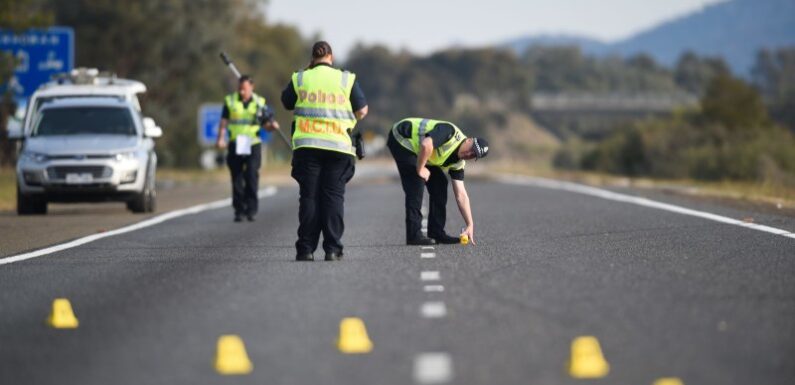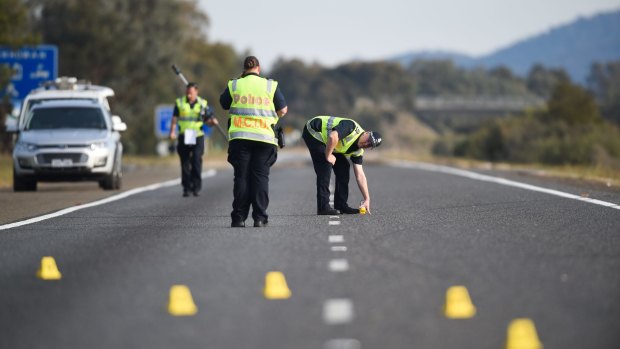
Save articles for later
Add articles to your saved list and come back to them any time.
Victoria is on the verge of recording more road deaths this year than in all of 2022, with fears the number of fatal crashes will continue to rise through the busy summer months.
A 24-year-old man from Traralgon became the 237th person to die in 2023 when the car he was travelling in lost control and hit a barrier on the Princes Freeway in Newborough, in the Latrobe Valley, on Tuesday.
Victoria Police officers investigate a crash on the Hume Freeway in 2017.Credit: Mark Jesser
That is only four people less than the full-year total of 241 in 2022, and surpasses the total in 2021 (234 deaths) and 2018 (213).
Transport Accident Commission data shows that the first 10 months of 2023 has been the deadliest on Victoria’s roads since 2016 and the second deadliest since 2010, with 32 more fatalities than during the same period in 2022.
Victoria Police assistant commissioner of road policing Glenn Weir said most fatal crashes were being caused by simple errors and “minor non-compliance” with road rules, and urged motorists to take more care heading into the summer period.
“More than half of the lives lost this year have been caused by people making really unfortunate low-level mistakes that have had catastrophic outcomes: things like low-range speeding, lower-end drunk driving, failing to obey road signs, using mobile devices and those sorts of things,” Weir said.
“We’ve got a real chance to do something because most of them are completely avoidable.”
Police believe at least 19 people killed in crashes this year were not wearing seatbelts.
Over the past five years, an average of 39 people died in crashes in November and December.
Road deaths have increased Australia-wide this year, with the national total up 6.8 per cent to 946 at the end of September – driven by an 28 per cent increase in deaths in NSW and a 60 per cent jump in South Australia.
Australian Automobile Association chief executive Michael Bradley said the Victorian and national road safety strategies were failing and would not meet their goal of halving road deaths from 2021 levels by 2030.
“We’ve got real problems out there which nobody can explain, and that’s because nobody seems particularly interested in a data-driven conversation about road trauma,” he said.
The automobile association – which is the peak national body made up of state-based motoring clubs including the RACV – is pushing for states and territories to release more data on the safety ratings of their road networks, the cause of serious crashes and the effectiveness of their law enforcement strategies.
Bradley said making $10 billion in annual federal road funding conditional on greater transparency would ensure that the most dangerous roads are prioritised for infrastructure upgrades and money is spent on the most effective safety measures.
“We know the things that cause the deaths and injury. The important bit is, what are the effective countermeasures?” he said.
Weir said Victorians may have developed a belief they could get away with dangerous driving during the COVID-19 pandemic, when there was a reduced police presence on the roads and drink- and drug-driving tests were suspended.
In response, he said police will take an “anytime, anywhere” enforcement approach in the coming months. Highway patrols and driver testing blitzes would be spread over more hours in the day and in more locations, Weir said.
There have been an unusually high number of multiple-fatality crashes this year, including 11 double fatalities compared to just two at the same time last year, he said, also noting the horror crash at Strathmerton in April which killed five.
Get the day’s breaking news, entertainment ideas and a long read to enjoy. Sign up to receive our Evening Edition newsletter.
Most Viewed in National
From our partners
Source: Read Full Article
